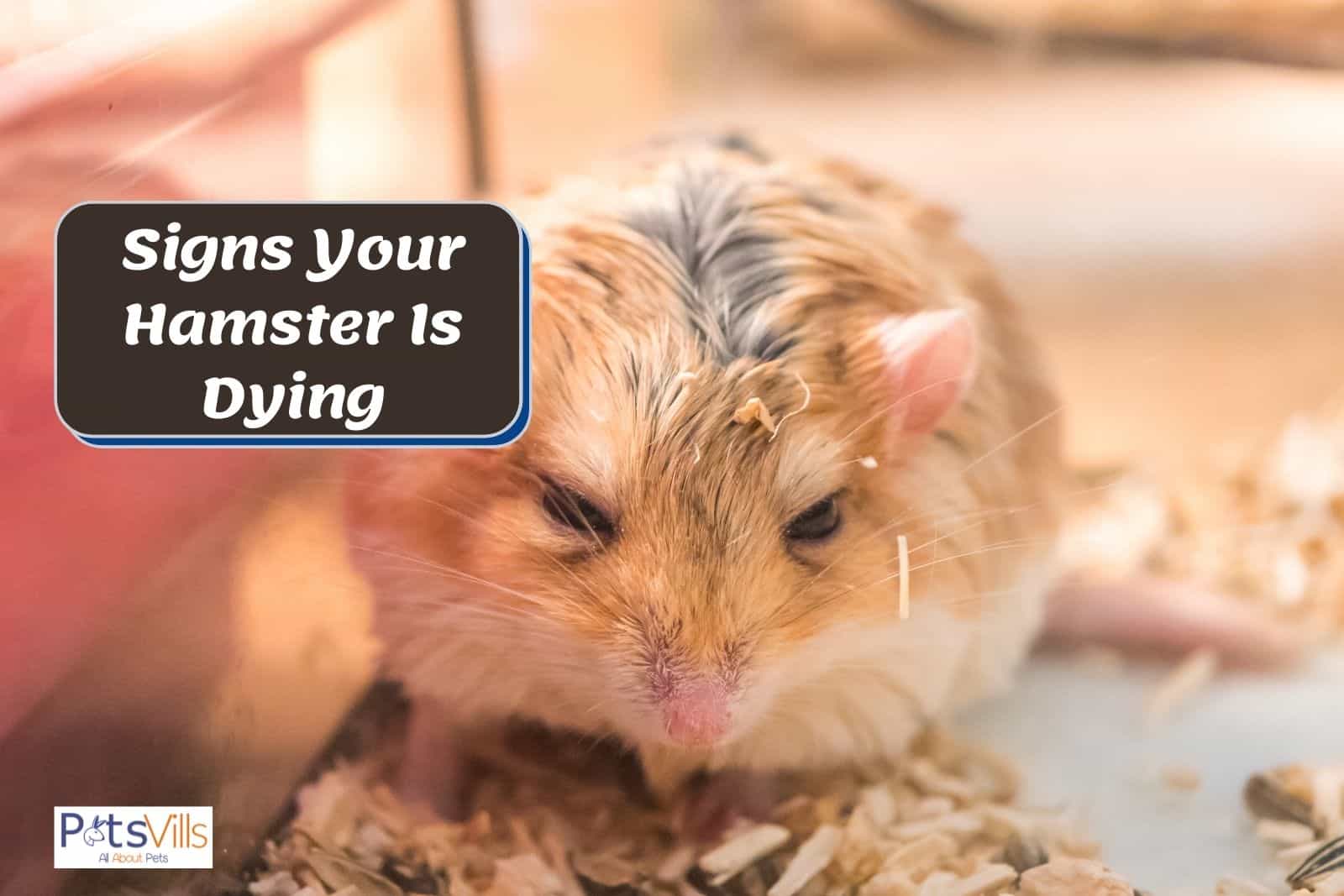Losing a pet is never an easy experience, but it’s inevitable, and since hamsters have a lifespan of 2-3 years, you need to be prepared for your hamster’s death.
Knowing the signs of a hamster dying can give you a chance to make your pet’s final days more comfortable or make the decision to put it to sleep if he’s in too much pain.
In some cases, it can even give you a chance to save your hamster from dying by getting your pet the necessary treatment.
So, in this article, I’ll tell you all about the signs of a hamster dying and how to prevent it, if possible, and give you a few tips on making your hamster’s last days as easy as possible.
Related: Can You Leave Hamsters Alone for a Week?
Table of Contents
How Long Do Hamsters Live?
Before getting to how to tell if a hamster is dead or dying, let’s talk about how long these adorable pets live.
Unfortunately, hamsters aren’t among the longest-living pets and have an average lifespan of 18-36 months, depending on their breed.
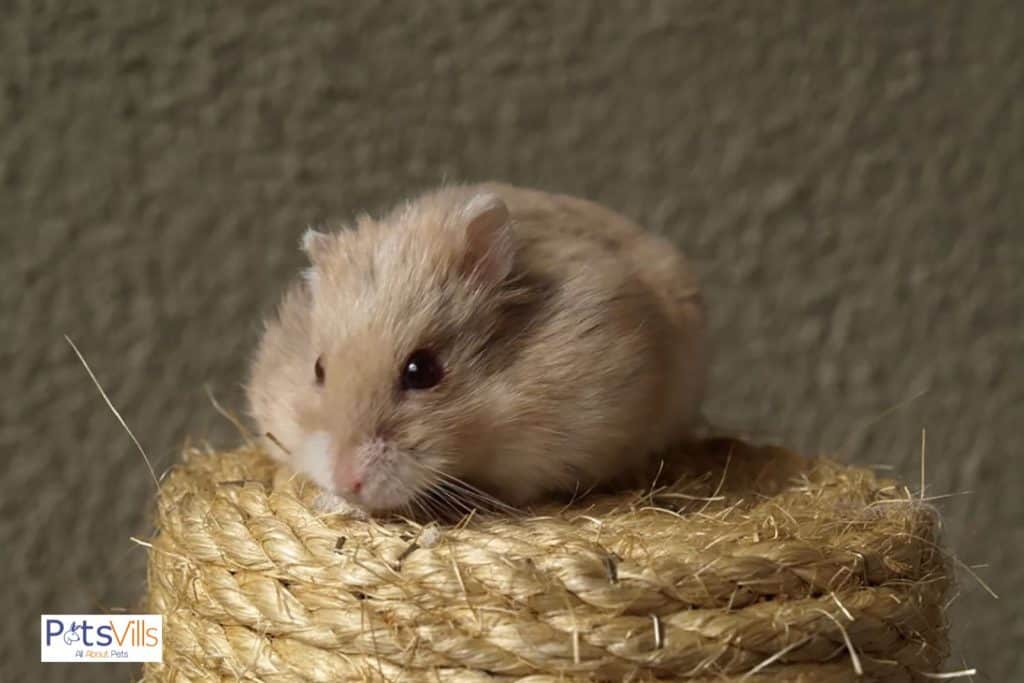
For example, the Roborovski Dwarf and Syrian hamsters live about 3-5 years, while the Chinese Dwarf has a lifespan of around two years.
It doesn’t seem much, but hamsters in captivity live longer than wild rodents. And they have better chances of surviving an illness, thanks to veterinary care.
Still, as vets from PetMD explain, “Any hamster that is a year and a half old is considered elderly.” Pet owners should provide proper diet, habitat, and care to keep them healthy for as long as possible. (1)
It’s also vital to keep an eye on common signs of illness in elderly hamsters so that you can get your pet rodent quality vet care.
But sometimes, your pet dies before you know something is wrong. What are the causes? Let’s find out!
CHECK: How to Know if My Hamster is Sick
Hamster Died Suddenly: What Are the Possible Causes?
Unfortunately, it’s not uncommon to find your pet hamster dead in its cage. And it can be quite a shock, especially if your pet hamster appeared healthy and thriving the day before.
So, how do hamsters die suddenly? Sudden death in hamsters is likely the result of underlying medical conditions, such as respiratory infections, cancer, and congestive heart failure.
Some pet hamsters may also have congenital defects that shorten their lifespan. These defects are the result of poor breeding practices in pet stores.
Stress also plays a big role in sudden hamster death. Hamsters are sensitive animals, and acute/chronic stress can increase the risk of heart attack and stroke.
Of course, some hamsters also die suddenly of old age. But in many cases, subtle signs tell you that your hamster is near the end of his life. Let’s see them.
10 Hamster Dying Symptoms
Before you start panicking about your pet dying, you should remember that these symptoms can also indicate that your hamster is sick. And if it’s sick, your pet can get better with treatment.
So, it’s vital to consult a vet before assuming that your hamster is dying of old age.
#1 A Drastic Change in Behavior
A sudden behavior change is one of the most common signs that something is wrong with your pet rodent. It can be an illness, but it can also signal that your pet hamster’s life is near its end.
Dying animals often change their behavior drastically. They hide, get clingy, and stop sticking to their usual routine because they’re scared and don’t know what’s happening.
That’s why it is important to spend time with your hamster to know its normal behavior. If you don’t do that, you may not be able to recognize changes in his behavior.
Try observing your hamster for 10-15 minutes a couple of times per day. You will quickly learn his habits, how much he sleeps, how much he eats and drinks, how active he is, etc.
Do this at different times of the day to get a sense of your pet’s daily routine.
So, when your hamster is feeling sick or dying, you will be able to notice those significant changes in his behavior.
#2 Lack of Activity
Besides changes in the hamster’s daily routine, low activity levels also indicate something is wrong.
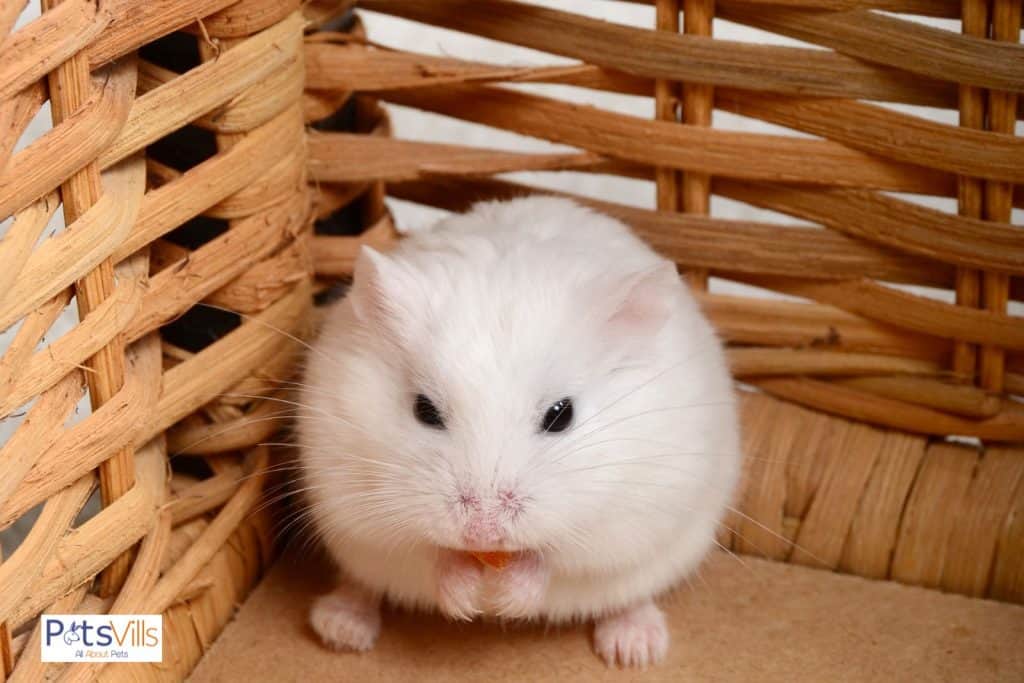
Hamsters are very active and can run up to eight kilometers per night. If your hamster seems lethargic, spends a lot of time not moving, and doesn’t seem interested in playing, it’s a sign that he is sick.
Your hamster’s movement may be slower than before, and he might sleep more than usual if he feels sick.
Moreover, the usual daily routine of hamsters involves cleaning themselves, nesting, and exercising. If you notice that your pet is not doing these things, he may be in pain or feeling under the weather.
#3 Sleeping More Than Usual/Hiding
In general, hamsters sleep around 8-12 hours per day. But baby or elderly hamsters can sleep up to 14 hours.
Hamsters are nocturnal, so they are more likely to be active during the night and sleep during the day. You shouldn’t worry too much if your pet spends the majority of the day napping.
However, hamsters don’t get their beauty sleep in one sleep cycle. Instead, it’s broken into smaller segments throughout the day. So, it’s not normal for a hamster to sleep 10-12 in a stretch.
Usually, dying hamsters don’t have much energy, so they’ll likely spend most of their time sleeping.
However, sleeping more than usual can also be hibernation. Hamsters hibernate when the temperature drops below 40°F as a way to survive during the winter months.
Hibernating hamsters will be in a very deep sleep and have shallow breaths and a slow heart rate. Their body temperature will also be lower than usual, and they can appear dead. (2)
If you suspect your hamster is hibernating, increase the room temperature and ensure that your furry friend has food and water when he wakes up.
I’ll talk more about how to know if a hamster is dead and not hibernating later on.
#4 Aggression
Your pet may become aggressive and prone to biting if he is experiencing pain or discomfort and doesn’t want to be bothered.
Dying hamsters are also in a state of vulnerability and stress that makes them more likely to act out when you attempt to approach them.
For example, your pet might refuse to approach your hand, hide when you try to pick it up or bite your fingers to keep you away.
How to Know if My Hamster is Sick
#5 Loss of Appetite
Healthy hamsters eat multiple times throughout the day. And even though hamsters spend the majority of the day napping, they’ll wake up to eat.
But even though hamsters eat often, they don’t actually eat that much. For example, according to Pethelpful, an average hamster will consume around two tablespoons of food on a daily basis. (3)
So, it’s vital to track how much your hamster is eating. A dying hamster won’t need as much food as a healthy one because its systems are shutting down. Lack of appetite is also the first sign of illness.
Unfortunately, it can be difficult to track how much your hamster is eating. While there may be no food in the bowl, hamsters are unbelievable hoarders.
They fill their cheek pouches with food and hide it around their cage. It’s an instinct to ensure they’ve got enough food to survive or to move their food to a more secure location.
With all this said, you should still be able to tell how much your hamster is eating. If you don’t have to fill the bowl as often as before, your hamster is eating less.
So, keep a closer look over his eating for a couple of days. If he stops eating altogether, take him to the vet straight away.
# 6 Gastrointestinal Illnesses
Dying hamsters will often suffer from some kind of gastrointestinal distress or illness. Many of them will experience pain in their stomach, which is one of the reasons why they might eat less and stay inactive.
Of course, GI problems are often not a sign of impending death, so take your hamster to the vet if you notice some symptoms.
These symptoms include vomiting, diarrhea, and loud stomach noises, which basically sound like the stomach growling humans experience as well.
Diarrhea can be particularly dangerous in hamsters because they’re small and get dehydrated quickly, which causes their system to shut down.
And here’s where I should mention the wet tail disease.
Wet tail is a deadly stomach infection often associated with stress and commonly caused by a number of bacteria.
This disease usually affects younger hamsters, particularly when they are at 3-8 weeks of age. It can be fatal if left untreated, often within 24 to 48 hours after symptoms appear.
The name of this disease comes from the fact that accompanying diarrhea can be so severe as to make the hamster’s tail and surrounding area dirty.
Look at the base of your pet’s tail to see if there’s a wet substance similar to mucus.
If you suspect your hamster suffers from a wet tail, get him to the vet immediately. He will treat your pet with antibiotics and IV fluids if your hamster becomes dehydrated.
#7 Change in Appearance
If your hamster is sick or dying, you will probably be able to spot numerous changes in its appearance, such as problems with its skin, fur, eyes, and weight.
Let’s take a look at the most common changes you can expect.
Skin Problems
Skin changes often indicate some health problems, especially infections which can cause redness, swelling, and even abscesses. The skin will be flaky and dry when an infection is present.
Untreated infections can be fatal for hamsters because they’re small, and it doesn’t take much to overwhelm their immune system.
Dry or dehydrated skin can also be a sign of some other problem. Check your hamster’s loose skin by lifting it over his shoulders and letting it go.
When you do this, the skin should go right back into place. If the skin is dehydrated, this will not happen. Dying animals are often dehydrated because they lack the energy to drink.
Skin problems can lead to scratching, so if you notice that your furry friend is scratching a lot, get him to the vet to get his skin checked out.
Fur Changes
Skin infections often affect the hamster’s fur as well. Usually, the hamster’s coat is shiny, soft, and without any bald patches.
If you notice that your hamster is losing fur alarmingly fast, it could be a symptom of infection or some other disease. Dying hamsters also have rough fur because they don’t groom.
Keep in mind that hamsters will have thinner fur as they age. That’s normal. However, losing a lot of fur at once is not and means your hamster is sick.
You should also check the fur around your hamster’s belly and tail. If it seems matted or feels wet, that can also indicate an infection.
Changes in the Eyes
As your hamster gets older, their eyes start to change and get more matte. Some hamsters may also get sticky eyes.
Sticky eyes are a pretty common problem in hamsters’ older years, caused by eye secretion that dries and sticks their eyelids shut while sleeping.
You can help them by using a small piece of wetted cotton and gently wiping their eyes. Although it generally affects older hamsters, it can affect younger ones too.
Look for Other Changes in Appearance
Check your hamster’s face, eyes, and mouth for any changes because they can also indicate a health problem.
Pay particular attention to a runny nose, puffy cheeks, and red eyes because they can be a sign of a common cold.
While catching a cold rarely threatens your hamster’s life, it can become a serious condition if it persists. In this case, visit your vet to treat the problem before it turns into something more dangerous.
When a hamster starts to reach late maturity, it will begin to get thinner, and its baby face will start to disappear. One of the most noticeable changes is that their neck will start to stand out more.
When they are younger, it’s hard to see where their neck ends and the stomach begins, but as they age, this will become more distinctive. The neck will start to change early, so don’t panic if you see this happen.
Other changes in appearance that may signal a serious health condition or death include an enlarged or swollen abdomen, bulging or squinting eyes, and even excessive urination.
#8 Difficulty Breathing
Hamsters that have severe health problems will often have trouble breathing normally. In fact, respiratory infections are probably the most common illness besides wet tails in hamsters. (4)
Pay attention to symptoms of labored breathing, such as wheezing or huffing. These are common hamsters dying noses, showing that your pet doesn’t have long.
Other breathing problems, like heavy and noisy breathing, may indicate a respiratory infection or other life-threatening conditions, like pneumonia.
Take your hamster to the vet if you notice breathing problems, and you may be able to prevent the development of a fatal health problem.
Keep in mind that hamsters can quickly take a turn for the worse, so you shouldn’t wait and see if the difficulty breathing goes away. It is better to be safe than sorry.
#9 Blood in Their Discharge
Do hamsters bleed when they die? Not always, but sudden blood discharge is not normal and should prepare you for the worst.
If you notice any bloody discharge coming from your hamster’s ears, nose, eyes, mouth, or anus, it could mean he is very sick and close to death.
Visit your vet to determine the cause and potential treatment plan since bloody discharge can indicate many health issues.
READ MORE: Do Female Hamsters Have Periods?
#10 Unpleasant Smell
Have you ever thought, “My hamster smells like death?” Your hamster’s coat may have a pungent aroma because of poor cage hygiene, but it can also be a sign of underlying disease.
I will take my hamster to the vet if I notice any sudden changes in how they smell. And I recommend you do the same, even if the cause is a dirty habitat.
Dirty cages are bad for hamsters because they increase the risk of infections and can shorten your pet’s lifespan.
And now, let’s talk about what to do if your hamster is dying.
You can also take a look at this video:
My Hamster is Dying: How to Look After Your Dying Hamster
If your hamster is dying, it is imperative to try to make his final days as easy as possible. You can achieve this by doing a few things.
#1 Keep Your Hamster Comfortable
It is important to make your furry friend comfortable in his last days, or even if he is just sick. So, if you have multiple hamsters in your habitat, separate the sick or dying hamsters.
They will be more comfortable, and you will allow your hamster to rest and stay away from stress. It will also prevent the spread of the disease and infection if your hamster’s problem is contagious.
This isolated habitat should be located away from other pets, family members, and noise of any kind. It should also be in a place without any bright lights.

The cage should be big enough and comfortable, even if your hamster doesn’t move much.
#2 Let Your Hamster Rest
When a hamster is very sick or dying, he needs comfort and rest. Don’t pick up your hamster often because you may disrupt his rest.
Also, if you try to pick him up, don’t be surprised if your pet becomes aggressive. Dying hamsters are often scared, and in pain, so they don’t want to be disturbed.
Keep in mind that sick hamsters may try to exercise, which can lead to injury. Your pet needs his rest at this time, so don’t put an exercise wheel in his cage if he is sick, and try to limit his movement otherwise.
#3 Keep His Cage Clean
While you don’t need to clean your hamster’s cage that often if he is sick or dying because you will disrupt his rest and may introduce stress and anxiety, you will still need to keep the cage clean.
As I already said, dirty cages breed bacteria, which can make your sick hamster worse. And if your pet has diarrhea and other stomach problems, the smell can be awful.
If you have multiple hamsters and plan to separate the sick or dying one in another habitat, clean it thoroughly with soapy water or use a bleach solution (just make sure to wash it out fully).
You should also clean the original habitat as well to minimize the risk of getting sick for the remaining hamsters.
And don’t forget to clean your hamster’s food and water bowls as well!
Here’s a video for tips on cleaning your hamster’s cage:
#4 Keep Your Hamster Warm
Sick hamsters will often refuse to eat or drink, making them feel cold. Some may even go into hibernation, which is not good for domestic hamsters.
You can put plenty of toilet paper in his cage, and he will use it to make a nest where he can rest and get warm. Use unscented paper and tear it into strips before you put it in his habitat.
Another thing you can do is put a heating pad in his habitat. You can also use a heat lamp to warm the cage up.
If you use a heat lamp, put a small house in your hamster’s habitat so he can escape the bright light.
Make sure that your hamster is warm but not too hot. Try to keep the temperature at around 70-85 degrees Fahrenheit (20-29 degrees Celsius).
If you overheat the cage, your pet can become stressed from the heat or even suffer from a heat stroke. And they you’d feel awful.
You can also try holding your pet hamster to provide warmth and comfort. Wrap them in a small towel and get the hamster close to your body. They may curl up and sleep, depending on how much they trust you.
Check out more tips on how to make a dying hamster comfortable.
#5 Provide Enough Food and Water
Dying hamsters are unlikely to eat or drink much, but you still need to ensure they have plenty of fresh food and water available.
In fact, you should try to get them to eat and drink a bit:
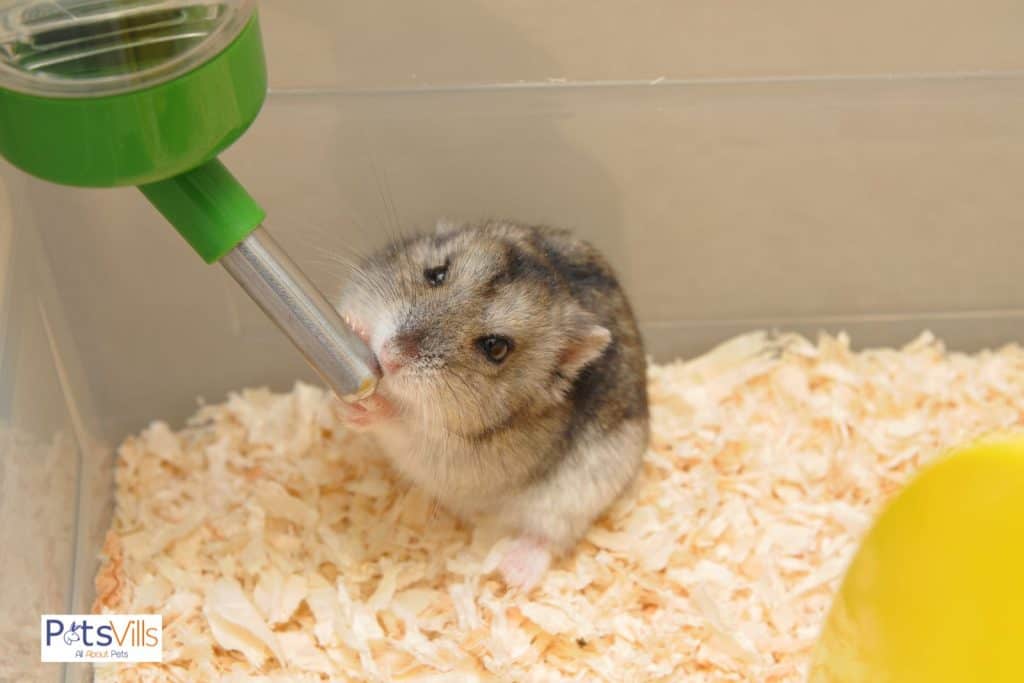
- To do this, put the food and water bowls close to his nest. Some hamsters will feel lethargic or won’t have enough energy to come to their bowls. This way, your pet can eat without moving too much.
- Try to feed your hamster high-protein foods. Protein can help your hamster regain its strength and recover, if possible.
- Some good choices include tofu, scrambled or hard-boiled eggs, yogurt with probiotics, bread soaked in milk, and small bits of cooked chicken.
- If they still aren’t eating, you could try feeding them some food by giving it or placing it right next to them.
Perhaps more important than getting enough food for an ailing hamster is getting enough liquid to stay hydrated, especially water.
Make sure that your hamster always has a source of fresh water. You can also feed him fruits with lots of water, like pears and apples.
But don’t force your pet because you’ll make his final days uncomfortable.
READ MORE: Hamster Drinking Water: How to Get Them Drink Enough
#6 Help Your Hamster Eat
If your hamster doesn’t eat or drink, you may try to feed him by hand or syringe to ensure that he gets the vital liquids and nutrients.
Put small pieces of food on your hands to see if your hamster will take it. Be patient with him and give him time to eat.
You may try to stroke your furry friend and talk to him to make him more comfortable as you try to feed him. Again, don’t force the issue, or your hamster might choke.
If this doesn’t work, you can try a 1cc syringe to give your hamster liquids and baby food. Put the syringe in the corner of his mouth, just behind his front teeth, and depress the plunger.
But be very careful. Dying hamsters may lose their ability to swallow, and you might choke your pet by accident.
#7 Consider Euthanization
Sometimes, there is nothing you can do to help your hamster.
When death is inevitable, you might want to take euthanization into consideration, especially if your hamster is in pain and you don’t want to see him suffer.
Euthanization is when you get a vet to put your pet down because they are in so much pain or their quality of life has decreased significantly.
While this decision is never easy, it is often right. Putting your hamster down is often the best thing for them. Work with your vet to decide when the time is right and how to do it.
And now, let’s talk about how to tell if your hamster is dead or hibernating.
Is My Hamster Dead?
So, what does a dead hamster look like?
Dead hamsters are limp at first, and then they become stiff. Their body is cold, and there’s no apparent breathing or movement. Some owners also use the word flat to explain what dead hamsters look like.
But when hamsters are hibernating, they have shallow breathing, slow pulse, don’t eliminate, and are cold to the touch. So, it’s easy to take them for dead, especially if you don’t know about hibernation.
If you’re unsure whether your hamster is dead or in hibernation, you can check by holding a mirror in front of your pet’s face. A slight fog indicates that your hamster is breathing and not dead.
Still, it’s dangerous for hamsters to stay in hibernation for long periods because they can die from dehydration. Make sure you increase the cage’s temperature and consult a vet.
Related: Why Do Hamsters Die So Easily?
FAQs
How do you save a dying hamster?
Once your hamster has started to die from old age, there isn’t much you can do. Move your hamster to a quiet and warm location, and try to make sure they are comfortable.
What causes a hamster to die suddenly?

Cardiomyopathy can cause your hamster to die suddenly. It is a heart disease that can affect hamsters of all ages. But stress in hamsters can also lead to sudden death.
Do hamsters die with their eyes open?
It depends; hamsters have been known to die with their eyes open and also with them closed.
Conclusion
Sadly, hamsters die after spending a few short years with us. You can’t do much to prevent old age, but you can increase your hamster’s lifespan by taking good care of it.
So, don’t ignore these signs of hamsters dying. Get your pet to the vet to determine if the vet can save your rodent or if it’s time to say goodbye. And remember to keep your hamster cage clean.
Do you know any other sign of a hamster dying that we missed here? Please let us know in the comments section below!
Barry Stingmore is a British content writer living in Fuerteventura, Spain. An animal lover at heart, he shares his home with a dog and four rescue cats and has a passion for writing about animals big and small.
Barry loves finding answers to your animal-related questions, the more research involved the better! You can rely on him to find the facts.
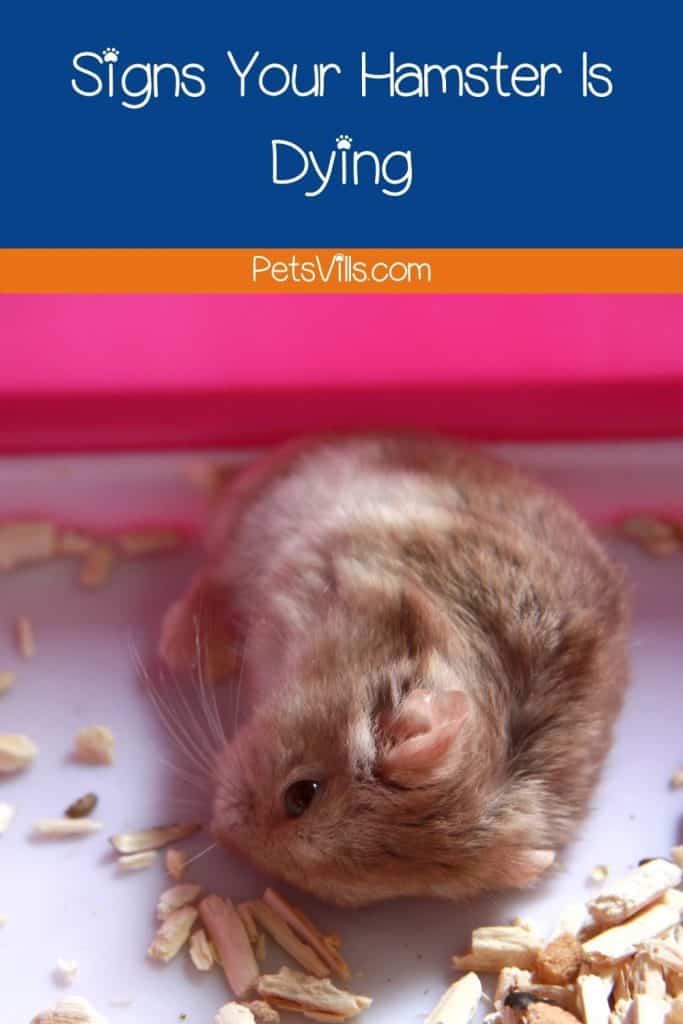
Do you know any other sign of a hamster dying that we missed here? Please let us know in the comments section below!
Resources
1. How Long Do Hamsters Live? [Internet]. www.petmd.com. Available from: https://www.petmd.com/exotic/care/evr_ex_hm_how-long-do-hamsters-live
2. Is my hamster hibernating or dead? [Internet]. Veterinary Practice. [cited 2023 Feb 9]. Available from: https://www.veterinary-practice.com/article/is-my-hamster-hibernating-or-dead
3. RenaSherwood. How Much Does a Hamster Need to Eat? [Internet]. PetHelpful. PetHelpful; 2007. Available from: https://pethelpful.com/rodents/How_Much_Does_A_Hamster_Need_To_Eat
4. Hamster Breathing Fast and Heavy? Causes and Treatment of Respiratory Illnesses [Internet]. PetHelpful. Available from: https://pethelpful.com/rodents/upper-respiratory-illness-hamsters
Barry Stingmore is a British content writer living in Fuerteventura, Spain. An animal lover at heart, he shares his home with a dog and four rescue cats and has a passion for writing about animals big and small.
Barry loves finding answers to your animal-related questions, the more research involved the better! You can rely on him to find the facts.
Find him on FACEBOOK, TWITTER AND Linkedin
Read his latest ARTICLES.
Find more about him HERE.

